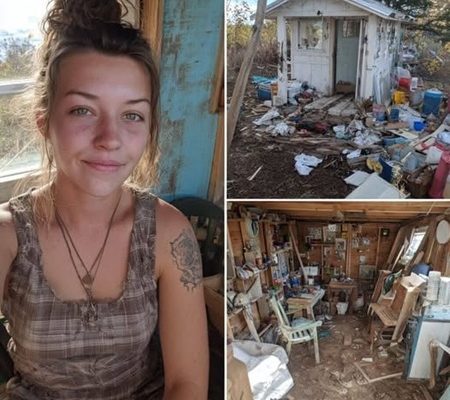After going through a difficult divorce, one woman decided to start over in the most unexpected way — by turning a small 10-by-11-foot shed into her dream home. What began as a simple project to regain her independence quickly became a symbol of strength, creativity, and a growing global movement: the rise of tiny living.
The Rise of the Tiny Home Lifestyle
Over the past decade, tiny homes have exploded in popularity. What was once considered a niche trend among minimalists and environmentalists has now become a lifestyle embraced by people from all walks of life — young professionals chasing financial freedom, retirees simplifying their lives, and families looking for sustainable living options.
Rising housing costs, urban crowding, and a renewed focus on eco-friendly living have all played a role in this cultural shift. For many, downsizing isn’t about sacrifice — it’s about freedom, peace of mind, and living intentionally.
Living Large in a Small Space
Tiny homes typically range from 100 to 400 square feet, far smaller than the average American house of over 2,000 square feet. But as many tiny homeowners say, “less is more.”
Every inch is designed with purpose — clever storage, multi-functional furniture, and bright, open designs make even the smallest spaces feel inviting and full of life.
This minimalist approach can also lead to powerful emotional benefits. Living with less means less clutter, fewer distractions, and a deeper appreciation for what truly matters. Many who embrace the lifestyle report reduced stress, better focus, and a stronger sense of control over their lives.
A Greener Way to Live
Tiny homes aren’t just about simplicity — they’re also about sustainability. Because of their small size, they consume far less energy to heat, cool, and maintain. Many are equipped with solar panels, rainwater collection systems, composting toilets, and energy-efficient lighting, helping owners live partially or fully off the grid.
This lifestyle significantly reduces one’s carbon footprint and encourages a closer connection with nature — whether nestled in a forest clearing or parked near a quiet lake.
Financial Freedom and Peace of Mind
Building or buying a tiny home is often much cheaper than traditional housing. Most tiny homes cost between $30,000 and $80,000, depending on design and materials. For many, this means no mortgage — and no lifelong debt. Lower monthly expenses on utilities, taxes, and maintenance also free up money for travel, hobbies, and savings.
For the woman who built her tiny home from a shed, this affordability was life-changing. She finally had a space that was hers — beautiful, efficient, and completely paid for.
Freedom to Move and Live Anywhere
Another reason people are drawn to tiny homes is mobility. Many models are built on trailers, allowing owners to tow their homes wherever life takes them. Whether it’s the mountains, the beach, or the countryside, the freedom to move brings peace of mind and adventure in equal measure.
In a world of uncertainty, having a home that can move with you is not just convenient — it’s empowering.
Building Communities Around Simple Living
Tiny homes have also inspired new communities built on shared values like sustainability and cooperation. Across the country, tiny home villages are popping up, featuring community gardens, shared spaces, and workshops that foster connection and creativity.
These communities are proof that small living can create big opportunities for friendship, resource sharing, and belonging.
Shaping the Future of Housing
The influence of tiny homes is reaching far beyond individual homeowners. Urban planners and architects are now incorporating small, efficient living units into affordable housing projects. Cities are beginning to update zoning laws to make room for tiny homes and accessory dwelling units (ADUs), helping combat housing shortages and homelessness.
This shift toward flexible, sustainable housing could reshape how cities grow in the future.
Challenges Along the Way
Of course, tiny living isn’t without challenges. Limited space requires organization and creativity. Privacy can be tricky, and not every city welcomes tiny homes yet due to restrictive zoning laws. But passionate advocates continue to push for change — proving that the movement isn’t just a trend, but a lasting solution for modern life.
A New Definition of “Home”
For many, including the woman who started with just a shed, a tiny home represents far more than shelter. It’s a declaration of independence, purpose, and resilience.
It shows that happiness doesn’t depend on square footage — it’s built through creativity, sustainability, and the freedom to live on your own terms.
As more people look for balance in a fast-changing world, the tiny home movement offers a hopeful glimpse of the future: one where less truly means more.



